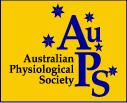
| Assessing and counteracting frailty during ageing — Organizer: Rene Koopman |
|
Andrea Maier,
University of Melbourne, Australia
– Assessing frailty in older individuals |
|
Stijn Soenen,
University of Adelaide, Australia
– Protein absorption and satiety in older individuals |
|
Luc van Loon,
Maastricht University, Netherlands
– Anabolic resistance with aging |
|
Rene Koopman,
University of Melbourne, Australia
– Novel nutritional interventions to counteract frailty and wasting |
| AuPS/Physiological Society of Japan Joint Symposium: Skeletal muscle physiology and function — Organizer: Graham Lamb |
|
Peter Currie,
Australian Regenerative Medicine Institute, Australia
– The genetics of vertebrate skeletal muscle assembly |
|
Yuji Hara,
Kyoto University, Japan
– The role of phospholipid flippase in myotube formation |
|
Takashi Murayama,
Juntendo University, Japan
– Molecular mechanism of type 1 ryanodine receptor-linked muscle diseases: toward diagnosis and therapy |
|
Bradley Launikonis,
The University of Queensland, Australia
– Calcium handling by human skeletal muscle fibres with ryanodine receptor variants |
| Cellular mechanisms of failure and arrhythmia in the diseased heart — Organizer: James Bell |
|
Davor Pavlovic,
University of Birmingham, UK
– Sodium pump and intracellular sodium in healthy and failing hearts |
|
Nicole Beard,
The University of Canberra, Australia
– Cellular mechanisms of failure and arrhythmia in the diseased heart |
|
Julie McMullen,
Baker IDI, Australia
– Novel therapeutic targets in heart failure and atrial fibrillation |
|
David Saint,
University of Adelaide, Australia
– Changes in atrial structure and function in diabetes and obesity |
| Emerging leaders in placental physiology — Organizer: James Cuffe |
|
Prabha Andraweera,
Robinson Research Institute, Australia
– Intrauterine environment and cardiovascular disease risk in later life |
|
Marloes Dekker ,
The University Of Queensland, Australia
– Maternal glucose metabolism and the gut and placental microbiota |
|
Jessica Griffith,
The University of Melbourne, Australia
– The impact of lifestyle and pharmacological interventions on the placenta in complicated pregnancies |
|
Olivia Holland,
Griffith University, Australia
– Mitochondrial adaptations and dynamics in the human placenta |
| How do calcium oscillations regulate biological rhythm? — Organizer: Livia Hool |
|
Dirk Van Helden,
University of Newcastle, Australia
– Synchronising pacemakers |
|
Fiona Britton,
University of Nevada Las Vegas, USA
– Understanding calcium-activated chloride channels in health and disease |
|
Grigori Rychkov,
University of Adelaide, Australia
– Oxygen dependent regulation of TRP channel function |
| Mitochondrial dynamics and function — Organizer: David Bishop |
|
Michael Ryan,
Monash University, Australia
– The machinery involved in mitochondrial dynamics |
|
Michael Lazarou,
Monash University, Australia
– The role and regulation of PINK1/Parkin mitophagy in maintaining mitochondrial health |
|
Robyn Murphy,
Department of Biochemistry and Genetics, Australia
– Effects of exercise training on mitochondrial content and dynamics |
|
David Bishop,
Victoria University, Australia
– Exercise prescription and mitochondrial content and function |
| Molecular mechanisms regulating skeletal muscle attributes in health and disease — Organizer: Paul Gregorevic |
|
Andrew Judge,
University of Florida, USA
– Investigating cellular processes that drive skeletal muscle wasting |
|
Kate Murphy,
University of Melbourne, Australia
– Novel mechanisms associated with cachexia during chemotherapy |
|
Nigel Turner,
University of New South Wales, Australia
– Increasing nuclear NAD+ biosynthesis alters skeletal muscle size and metabolism |
|
Nigel Laing,
University of Western Australia, Australia
– Functional genomics in disease gene discovery and diagnosis of Mendelian disorders |
| New directions in ischemia cardioprotection — Organizer: Lea Delbridge |
|
Livia Hool,
University of Western Australia, Australia
– Role of nano-particles in ischemia-reperfusion therapies |
|
Pete Jones,
University of Otago, New Zealand
– Impact of reactive oxygen species production on calcium release during ischemia-reperfusion injury |
|
Derek Hausenloy,
Duke-NUS Medical School , Singapore
– Remote ischaemic conditioning for cardioprotection: Bench to bedside in action! |
|
Shiang (Max) Lim,
St Vincent's Institute of Medical Research, Australia
– Using cardiac stem cells to rescue the ischemic heart |
| Problems in labour: Mother Nature versus Father Time — Organizer: Helena Parkington |
|
Susan Wray,
University of Liverpool, UK
– Is hypoxia good for labour? |
|
Sam Mesiano,
Case Western Reserve University, USA
– Preventing premature birth by exploiting anti-inflammatory actions of progesterone |
|
Martha Lappas,
University of Melbourne, Australia
– Prevention of preterm birth: Novel targets of inflammation in the myometrium |
|
Helena Parkington,
Monash University, Australia
– Mechanisms contributing to Failure-to-Progress in human labour |
| Strategies for large-scale and authentic assessment of undergraduates — Organizer: Julia Choate |
|
Paul White,
Monash University, Australia
– Development and assessment of problem-solving skills |
|
Richard Vickery,
University of New South Wales, Australia
– Student Peer Assessment: An efficient assessment method to enhance critical evaluation? |
|
Yvonne Hodgson,
Monash University, Australia
– Academic and student perceptions of assessment |
|
Harrison Gray,
University of Queensland, Australia
– Professional identity in allied health students: How it affects authentic assessment |
| The preterm baby — Organizer: Janna Morrison |
|
Tim Moss,
Hudson Institute of Medical Research, Australia
– There is no such thing as a normal preterm baby |
|
Barbara Lingwood,
University of Queensland, Australia
– Supporting preterm cardiovascular function |
|
Rob Galinsky,
University of Auckland, Australia
– Improving brain development in preterm infants with hypoxic-ischaemic encephalopathy |
|
Max Berry,
Otago University, New Zealand
– Big data for small babies; the impact of gestational age on health and educational outcomes in New Zealand |